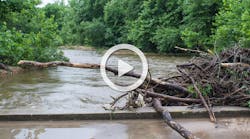The Struggle To Fit In
In recent years, engineers have been tasked with trying to fit more into less space. Environmental or fiscal constraints—or both—necessitate green and high-density projects with limited land disturbance.
As engineers try to squeeze more into less, we turn to retaining walls, steeper slopes or retained soil slopes to aid our effort. Even though cost is a factor in the project equation, gone are the days of plain concrete gravity or parapet retaining walls, as aesthetics are as important to end-users as function.
Mechanically stabilized earthen and segmental block wall systems can be appealing to the eye, but at what expense? Steep slopes and retained soil slopes (RSSs) are less expensive and more natural-looking approaches to retaining soil, but they bring about their own set of challenges, including controlling erosion and establishing permanent vegetation for long-term slope stability.
The advances made in hydroseeding, in both techniques and materials, have come to our rescue. Hydroseeding using long-life flexible growth medium (FGM) often is overlooked as a solution for establishing vegetation on slopes and RSSs. FGMs use either a wood or coconut fiber and can last up to 24 months before decomposing. The natural fibers are processed together with poly-fibers and multiple types of tackifier, which allows the mulch to adhere even to vertical surfaces.
Hydroseeding with an FGM also provides the best seed-to-soil contact and dramatically lowers the risk of undermining, which can happen with traditional blankets. Traditional blankets require smooth grading to ensure good contact with soil, whereas an FGM will conform to an uneven and rough ground surface. When blankets are perched above a depression, the seed is not protected and can be washed away. Another added benefit of hydroseeding is the reduced time needed for installation. Most rolled erosion control blankets require labor-intensive trenching and stapling, and the additional labor costs more than compensating for hydroseeding using better materials.
Developing the right solution for a slope or RSS does not have to be difficult, but the typical “cut-and-paste” seeding specification may not give the desired results. That is when it is time to call in the professionals that know which mulch and grass types fit a particular situation and will help develop the right specification for the job.
A diverse mix of perennial and annual grasses and flowers are available to choose from, depending on the climate and the desired look. Soil amendments also are critical for sustainable permanent vegetation. All the common soil amendments can be added directly to the slurry, but the main advantage of hydroseeding is that bio-stimulants and beneficial bacteria can be added for increased root and shoot growth.
When hydroseeding slopes and RSSs, it is best to get it right the first time. It is crucial, therefore, to use the best that nature and technology have given us for sustainable vegetation. With the right tools in your toolbox, it is easy to give your clients a less expensive and more natural-looking retaining wall and feel confident in the long-term results.
Download: Here

